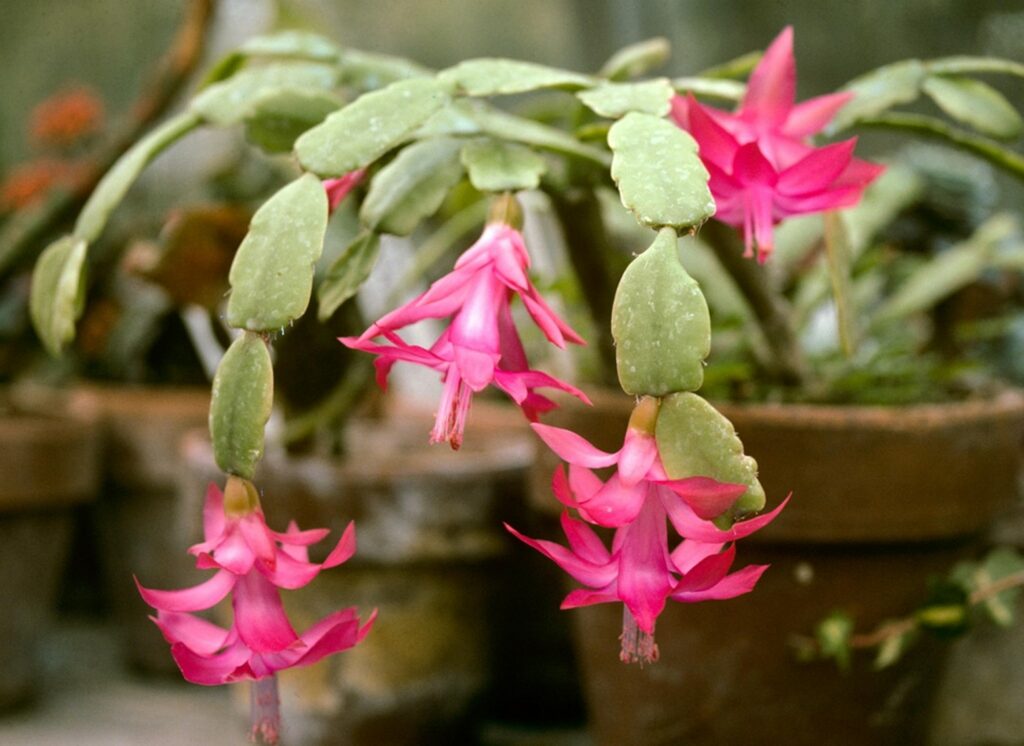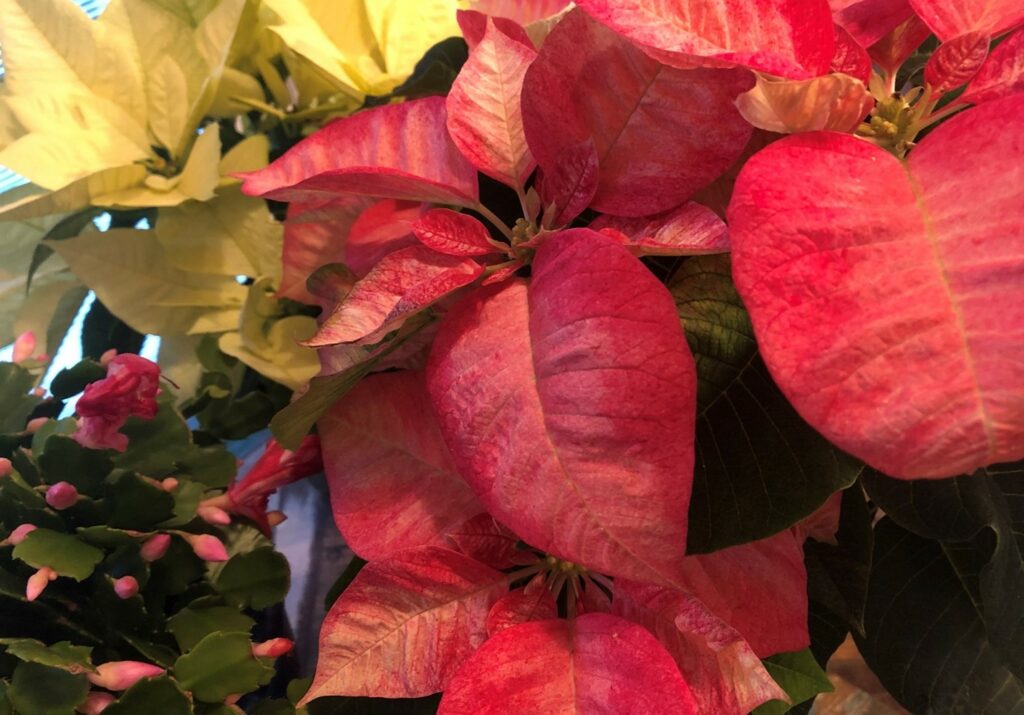
97.9 The Hill and Chapelboro.com have partnered with Orange County Master Gardeners for “Playing in the Dirt,” a monthly column exploring the fertile ground of home gardening in our community and intended to provide the information and inspiration gardeners of all skills levels need to flourish! Check back on Chapelboro each month for a new subject – from our gardens to yours!
By Lynn Calder, Orange County Master Gardener volunteer
Colorful holiday plants are everywhere adding beauty to indoor spaces throughout December. You can continue to enjoy them after the New Year! Here are tips for keeping some of the most popular holiday plants healthy after the tree has been mulched and decorations have been sent back to the attic.
Light and Water
Proper light and water are the most important factors for keeping any indoor plant healthy. Several popular holiday plants — poinsettias, Christmas cactus, amaryllis and anthurium — have similar water and light requirements. They should be placed away from drafts in a room where they will receive bright (but not direct) sunlight at least six hours a day. Keep the soil moist but not wet: water with tepid or warm water when the surface is just dry to the touch or the pot feels light when lifted. Remove or make holes in wrapping so the plant can drain well when watered. Discard water in the drainage tray; the plants should not sit in water. The best temperature for these plants in the house is about 70 degrees during the day and 60 to 65 degrees at night. For more information about growing houseplants, see Playing in the Dirt from last January.
Poinsettias (Euphorbia pulcherrima)
The parts we think of as flowers on a poinsettia — the colorful modified leaves — are bracts and the yellow center is the flower. Your poinsettia can thrive after the holidays as an attractive green plant in a room with bright, indirect sun. To encourage new growth, cut the plant back to about eight inches in height after the bracts have aged and become unsightly and fertilize it about once a month with an all-purpose household plant solution mixed at half strength.
Once outside night temperatures average over 55 degrees, you can place it outside in its container or plant it in a garden. Whether potted or in the ground, the poinsettia will continue to need good drainage, with plenty of organic matter added to the potting mix or soil, and four to five hours of indirect sunlight per day. If it remains potted, be sure to bring it back in the house when temperatures drop below 55 degrees at night.
To bloom again, the poinsettia must have a period of complete darkness in the fall. Follow these steps to produce colorful bracts next holiday season and see this article for more tips about keeping your poinsettia healthy. NOTE: Poinsettias are not poisonous though the leaves are very mildly toxic if eaten.

Flowers and stems of Christmas cactus (Schlumbergera russelliana). (Photo by Wayne Rae. Public Domain Mark 1.0.)
Christmas Cactus
“Christmas” and “cactus” are misleading terms for this flowering holiday plant. A holiday cactus is a “forest cactus” — a succulent native to tropical rainforests — not a desert cactus. Three distinct species, Christmas cactus (Schlumbergera russelliana), Thanksgiving cactus (Schlumbergera truncata) and Easter cactus (Rhipsalidopsis gaertneri) are distinguished by the time of year in North America they bloom, the way the flower blooms, and the shape of the stems and leaves. Many of the plants available for sale are hybrid crosses of Christmas and Thanksgiving cacti that bloom through December.
After blooming, keep the holiday cactus in an area of your home with bright, indirect light. Add humidity by placing it on a tray with moist gravel or misting occasionally. It can be moved outside to a shady garden spot once temperatures are above 50 degrees at night and moved back inside when temperatures cool to below 50 degrees at night in fall. Pruning the cactus by cutting a few sections off each stem in late spring will encourage branching and more flowers later. Propagate the cuttings by placing them in moist potting soil to root — you’ll produce more holiday cacti! A succulent potting mix is a good choice whenever you repot the plant. When actively growing, fertilize the cactus with a water-soluble all-purpose solution at half strength one to two times a month. See this article for more information about growing holiday cacti. If cared for properly, these plants have been known to live up to 100 years!
Holiday cacti generally re-bloom at the holiday more consistently than poinsettias. For advice about ensuring new buds, see Christmas Cactus Care. NOTE: Holiday cacti are not toxic at all.

Anthurium (Anthurium andraeanum) with yellow spadix. (Photo by Jair Araujo De Assis, CC BY-SA 3.0.)
Anthurium (Anthurium scherzerianum, Anthurium andraeanum)
Anthurium has glossy, green heart-shaped leaves; a brightly colored petal-like part of the flower, called a spathe (a modified leaf) in shades of red, rose, pink and white; and a tail-like true flower spadix protruding out of the middle of the spathe. The most common species available are A. scherzerianum (with a curly spadix) and A. andraeanum (with a straight spadix). A healthy anthurium can bloom many months of the year indoors.
Anthurium likes humidity (misting helps in a dry environment) and can tolerate more warmth in the room (up to 85 degrees). It needs well-draining soil with lots of organic matter; it will not grow well in compacted soil and should not sit in a tray of excess water. Fertilize with a water-soluble houseplant fertilizer high in phosphorus every two weeks in spring and summer (growing season) and to encourage more blooms. Repot the anthurium every two years, or sooner if the plant becomes root-bound in its container. For more growing information, see this article in the NC Extension Gardener Plant Toolbox with link to an explanatory video. BEWARE: Some species of anthurium are poisonous.

Amaryllis bulb in a pot. (Photo by Dwight Sipler, CC BY 2.0.)
A Holiday Bulb — Amaryllis (Hippeastrum)
Amaryllis bulbs are often sold in kits with instructions about forcing the bulb to bloom. Bulbs that were sold blooming at the holidays were forced to bloom by being exposed to particular cool and dry conditions — they naturally bloom in spring or early summer. After blooming, remove flowers and cut the stalk just above the bulb. Wait to remove the leaves until they have yellowed and started dying. The leaves will keep growing by placing the pot in a warm, sunny spot, watering regularly, and fertilizing weekly with a balanced houseplant fertilizer.
After cutting back the stalk and leaves, you can plant the bulb in your garden once the risk of frost has passed. Plant it in well-draining soil leaving one-third of the bulb above ground and place mulch around it to conserve moisture and discourage weeds. Some of our very cold winters may damage amaryllis bulbs planted outside; help protect them with a thick layer of mulch in winter. Outside, the amaryllis will return to its natural bloom cycle of late spring to early summer next year. You can also keep the bulb in a pot to bring inside during the winter. See Growing Amaryllis Bulbs for more tips.
If you’d like to force your potted bulb to bloom for the holidays next year, see Home Forcing of Potted Amaryllis (Hippeastrum). Some amaryllis bulbs are sold coated with red wax. If you want to try planting one of these bulbs, be sure to strip off all the wax first, being careful not to damage the bulb. BEWARE: amaryllis is toxic to all mammals!
Other Holiday Plants
If you’ve received or bought other varieties of houseplants this season, be sure to check the North Carolina Extension Gardener Plant Toolbox for care-taking and growing information.
Want to know more?
- List of poinsettia cultivars with photos. NC State Extension Poinsettia Trials.
- Poinsettias, North Carolina Cooperative Extension, Henderson County.
- Plants of the Holiday Season. North Carolina Cooperative Extension, Chatham County.
- Anthurium — Commercial website dedicated to cut flowers and potted plants.
- Pet Poison Helpline, 855-764-7661: Available 24 hours a day!
- ASPCA Animal Poison Control Center, 888-426-4435.
Check us out!
Have a plant or garden question? Email the Orange County Master Gardener Volunteers at ocmgardeners@gmail.com or phone 919-245-2061.
Learn about winter sowing, an easy way to start seeds in cold weather, at our next Dig Deeper talk, Jan. 21 at 2 p.m. at the Orange County Library. The speaker is Mary Leonhardi, a Master Gardener volunteer who has directed seed harvesting and cleaning for the JC Raulston Arboretum’s seed bank program. Pick up free seed packets from our Community Seed Library team! More information here.
Subscribe to The Garden Buzz, the Orange County Master Gardeners’ monthly newsletter, for gardening news and tips. And visit our website, The Orange Gardener.
Chapelboro.com does not charge subscription fees, and you can directly support our efforts in local journalism here. Want more of what you see on Chapelboro? Let us bring free local news and community information to you by signing up for our biweekly newsletter.



